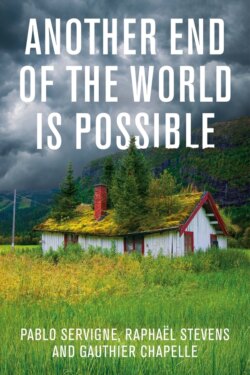Читать книгу Another End of the World is Possible - Pablo Servigne - Страница 15
Breaking down walls
ОглавлениеIt has already been some years since we formed the desire to make as many people as possible come to understand the scientific work on this subject. We haven’t yet lost our spirits, or hope, or our reason. We appreciate now that going beyond the strict scientific framework has been a great help for us on this journey. It has even been a source of joy.
Both the partial collapses that are taking place already and the possible systemic collapses of the future are opportunities for transformation. We remain convinced that it is possible to understand, to speak and to live the catastrophes and the sufferings that they generate without giving up joy or the possibility of a future.
This book tells of our discoveries in the fields of disaster psychology but also of our encounters on the paths of ‘collapsosophy’. It is aimed at people who want to navigate this balance of light and dark, without giving up their clarity of vision or their sense of reality, but also without renouncing their sense of a future which may be joyful, and in any case is of this earth. Because the question asked by Bruno Latour is the question of our generation:
Do we continue to nourish dreams of escaping, or do we start seeking a place on the earth that we and our children can inhabit? Either we deny the existence of the problem, or else we look for a place to land, to come to earth. From now on, this is what divides us all, much more than our positions on the right or the left side of the political spectrum.33
In this book, we report on streams of thought that may be unfamiliar to many readers. We also make connections between areas that may at first seem to have nothing to do with each other. We are aware that this could upset some people. Reading these pages will ask of you a spirit of openness, curiosity and understanding. But this is the nature of a transdisciplinary enterprise (see chapter 4).
This attitude of openness also involves a mistrust of the taken-for-granted labels, clichés and caricatures that are used mainly to discredit: survivalist, snowflake, fascist, leftist, new age, mystic, etc. These labels should not prevent us from looking at the complexity (or the emptiness) that may be hidden behind them.
Treat this book as a visit to a huge wild vegetable garden. Feel free to walk around and pick up what you like, or to learn about what you do not know. There is colour and life, there are fruits ready to pick and connections which still can’t be seen. And like the Kogi Indians, fill two saddlebags. Fill the one on the right with what speaks to you and suits you; fill the one on the left with what you disapprove of or what seems irrelevant today, so that you can come back to it later.
In the first part of the book, we explore the impact that the coming disasters may have on our mental health, as well as the ways in which we can recover. How do we absorb this news and this understanding? How do we get used to living with it, over the coming decades? How should we announce it to those around us? Do hope and optimism still make sense?
In the second part, we explore three ways of changing our outlook on the world, so as to help us find meaning, or at least to step aside a little. Why and how can we change our relationship to science and knowledge? Why and how can we open ourselves up to other ways of seeing the world developed by other cultures which are less ‘thermo-industrial’? More generally, isn’t it time to change the stories we tell ourselves?
And in the third part, we enter more deeply into ‘collapsosophy’. We start by approaching the essential question of the connections which we shall need to weave with ourselves, between ourselves, and with other living beings. Then we open up to questions that give meaning to our time and to our lives: the process of growing up and ‘becoming an adult’, the male–female relationship, the return to the wild, and the ways in which we can go through all of this together.
The impetus of this book is to explore, beginning from the knowledge, experiences and intuitions which each person already has. It is to share the joy of learning further, to provoke moments of realization, to explore our shadows, to meet with people who take us out of our comfort zone, to begin a dialogue with trees, rivers and salamanders, to accompany each other through suffering and mourning, and to participate together in the emergence of what is going to happen.
